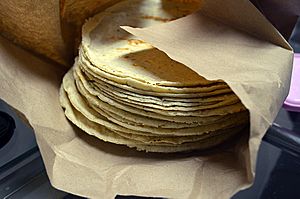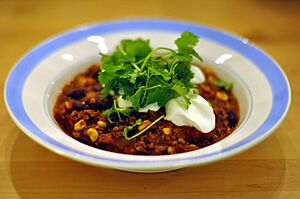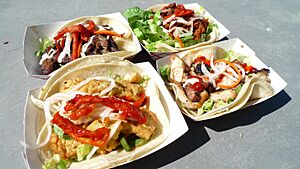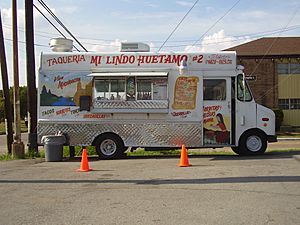Mexican-American cuisine facts for kids
Mexican food is a mix of many cultures and tastes. It has spread all over the world, and it's very popular in the United States. Foods like tortillas, salsa, chips, chili, burritos, and tacos are what many Americans think of as Mexican food.
Because of big companies, people moving to the US, and how much everyone likes it, Mexican dishes are now common in American homes. Some of these popular Mexican foods are quite different from their original Mexican recipes. Still, they are a big part of what many Americans eat. Also, more traditional Mexican food is becoming popular across the United States, even far from the border.
Contents
The Story of Mexican Food
How Mexican Food Began
Corn was super important to the ancient Aztec people. It grew well even when it was dry and gave lots of food. They used corn in many ways, like:
- Atole - a thick, paste-like soup made from boiled corn.
- Tortillas - flatbreads made from ground corn, cooked on hot clay.
- Tamales - steamed corn dough that felt spongy.
Native vegetables included squash, tomatillos, tomatoes, cactus, and chili peppers. These veggies were used to make many sauces. They were often cooked with corn in different dishes. Fish, birds, larger animals, insects, berries, fruits, and rice were also common foods. Chocolate was a special treat for these groups.
Spanish Influence on Food
When Spanish explorers came to the New World, they hoped to find foods like those in Spain. But Aztec food was very different. The main crops were not enough to feed the animals and people the Spanish wanted to bring. The Spanish thought corn was better for pigs than for people.
The Spanish brought wheat to the native people. They used it to make flour tortillas. Spanish settlers also brought cows, sheep, goats, pigs, horses, and donkeys. These animals were used for food and work. It took time for native people to get used to these European tastes. But over time, the cultures and their foods mixed together.
After Mexico Became Independent
By the 1700s, Spanish food had become less spicy than it used to be. This was very different from Mexican food around the time of the Mexican Revolution. Instead of changing their food to be like Spain's, Mexicans wanted to celebrate their own history. They kept using chili peppers as a key part of many dishes. This was one of the first big differences between the new country of Mexico and Spain.
Mexican Food Comes to the United States
American soldiers first tasted Mexican flavors in Texas in the 1800s. Some say that a few Mexican foods became more popular at the 1893 World's Fair in Chicago. Especially in Texas, dishes like chili con carne and tamales became favorites. Chili con carne was later sold as "chili" in cans. This helped it spread to more Americans.
Some Mexican food came to the United States because the U.S. gained land from Mexico. This happened after the Mexican-American War and the Treaty of Guadalupe Hidalgo in 1848. When the U.S. border moved, many Mexican citizens lived in what became the American Southwest. They kept their food traditions alive.
Also, many Mexicans moved to the United States. This started in the 1800s for railroad and farm jobs. Mexican workers were important in the American Southwest. Later, programs like the Bracero Program (1942-1964) brought millions of Mexican workers to the U.S. for temporary jobs. With more workers came more Mexican food in areas that had not seen much Mexican culture before.
Tex-Mex Food
Cultural differences are not as clear as they used to be. You can see this along the Mexican-U.S. border in states like California, New Mexico, Arizona, and Texas. These states share many things with Mexican culture. This mix is called "cultural hybridity." It happened because many Mexicans moved to the Southwestern States in the 1800s. Since then, Mexican food has become the most popular non-native food in America. Mexican cooking styles brought to the Southwest quickly mixed with local culture. This created a new type of Mexican-style food, now known as Tex-Mex. This new food style started in the American Southwest. Over time, it spread to other parts of the U.S. and the world.
Making Food for Everyone
With new factories and big companies, many businesses started making lots of food. This was especially true for Tex-Mex style foods. This made Americanized Mexican food available to many more people. It spread not only in America but also around the world.
Examples of mass-produced Tex-Mex food include canned chili, which is a mixed version of Mexican "chile con carne." There are also packaged tortillas, boxes of pre-cooked taco shells, frozen burritos, pre-made guacamole, bottled salsa, and bottled nacho cheese. Many Americans think these foods are authentic Mexican foods. But they are not. Commercial Mexican food in the United States is a huge business, worth $41 billion. These companies use some ideas from real Mexican food. But they change them using American ingredients and styles to appeal to many American customers. Many of these companies started in the 1900s. This shows that Mexican-style foods became popular in America fairly recently.
American Food Companies
Many companies have made money from Americans' love for their version of Mexican food. While companies that make real Mexican ingredients exist near the border, the Americanized versions are much more common. You can find them in grocery stores all over the country. Many of these companies use Spanish words or names for their brands. This makes them seem more real. But many are actually owned by big companies like Frito-Lay.
| Company Name | Year Introduced | Primary Products |
|---|---|---|
| Mission | 1977 | Tortillas |
| Pace | 1947 | Bottled Salsa |
| La Costeña | 1923 | Canned Chilies & Beans |
| Hormel | 1891 | Canned Chili |
| Old El Paso | 1938 | Taco Shells, Spices, Re-fried Beans |
| Tostitos | 1979 | Corn Tortilla Chips |
| José Olé | 2000 | Frozen Tacos, Burritos, Taquitos |
| La Victoria | 1917 | Enchilada Sauce, Nacho Cheese |
Americanized Mexican Restaurants
"Mexican" restaurants are a big part of the restaurant business in the United States. Many of the most popular ones are large chains with locations everywhere. The five biggest Mexican restaurant chains in America in 2017 were Taco Bell, Chipotle Mexican Grill, Qdoba Mexican Grill, Moe's Southwest Grill, and Del Taco. These restaurant chains all offer an Americanized version of Mexican food. They have few similarities to real Mexican cooking. These chains keep growing. But more and more people are also starting to recognize and enjoy traditional Mexican food.
These mixed-style restaurants are popular in the U.S., but not always in Mexico. In Tijuana, a city across the border from San Diego, chefs want to keep traditional Mexican cooking styles alive. Many chefs in Tijuana stick to classic Mexican foods. They try to avoid the North American ideas of Mexican food to protect their cooking traditions.
Real Mexican Dishes Becoming More Popular
Even though Americanized Mexican food is still very popular, more traditional Mexican dishes are also growing in the United States. With more Mexican restaurants, taco stands (taquerias), and taco trucks appearing, many Americans are learning to love Mexican food in its original form. Also, Mexican food is starting to appear in fancy restaurants. People are seeing the amazing flavors that traditional Mexican dishes can offer. This shows that younger generations often prefer real foods over Americanized ones. Many Americans are looking for family-run Mexican restaurants that serve traditional dishes. They are also becoming more interested in learning how to make these dishes at home. Many newer Mexican restaurants in the United States mix parts of both traditional Mexican food and Americanized Tex-Mex food on their menus.





